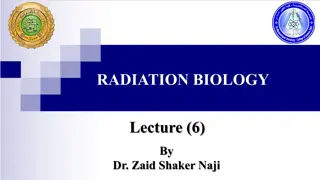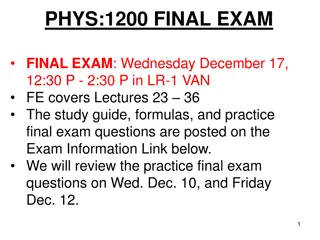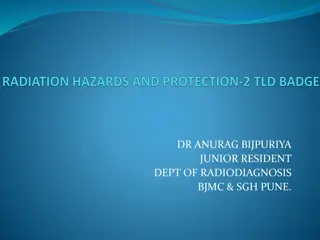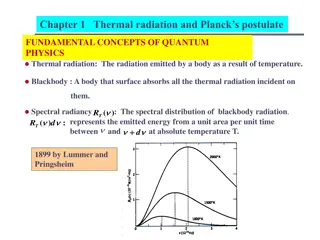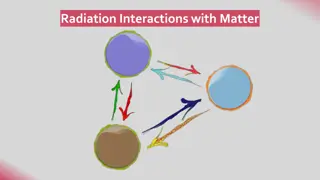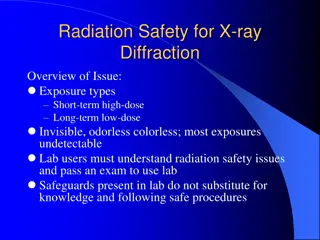Understanding Radiation and Its Effects on Health
Radiation is a form of energy that can be emitted from radioactive materials in the form of particles or waves. It can be either ionizing or non-ionizing, with ionizing radiation having the ability to penetrate tissues and deposit energy within them. While alpha particles, beta particles, x-rays, and gamma rays are forms of ionizing radiation, non-ionizing radiation includes ultraviolet, visible light, infrared, microwave, and radio frequency radiation. Knowing the differences between these types of radiation is crucial for understanding their effects on health.
Download Presentation

Please find below an Image/Link to download the presentation.
The content on the website is provided AS IS for your information and personal use only. It may not be sold, licensed, or shared on other websites without obtaining consent from the author. Download presentation by click this link. If you encounter any issues during the download, it is possible that the publisher has removed the file from their server.
E N D
Presentation Transcript
RADIATION AND HEALTH BELLO C. B.
INTRODUCTION Radiation is energy that moves through space or matter at a very high speed. This energy can be in the form of particles, e.g. alpha or beta particles, which are emitted from radioactive materials, or waves e. g light, heat, radio-waves, microwaves, x-rays and gamma rays. Radioactive materials, also known as radio-nuclides or radioisotopes, are atoms that are unstable. In nature, there is a tendency for unstable atoms to release radiation as they change form
INTRODUCTION CONTD Radiation that can produce ions when it interacts with matter is called ionizing radiation. Alpha particles, beta particles, x-rays and gamma rays are forms of ionizing radiation. Radiation that is not capable of producing ions in matter is known as non-ionizing radiation. Radio- waves, microwaves, heat waves, visible light and ultraviolet radiation are forms of non-ionizing radiation.
IONIZING RADIATION Ionizing radiation is a type of energy released by atoms that travels in the form of electromagnetic waves (gamma or X-rays) or particles (neutrons, beta or alpha). The spontaneous disintegration of atoms is called radioactivity, and the excess energy emitted is a form of ionizing radiation. Unstable elements which disintegrate and emit ionizing radiation are called radio-nuclides.
IONIZING RADIATION The term ionizing radiation is applied to radiation that has the ability to penetrate tissues and deposit its energy within them. There are 2 types: Electromagnetic radiations- x-rays and gamma rays Corpuscular radiations- alpha particles, Beta particles (electrons) and protons. Alpha particles are 10 times as harmful as X-rays, beta particles or gamma rays, Alpha particles though have little penetrating force, they are very dangerous when entered into the body. X-ray and gamma ray have short wave length, they are deep penetrating radiations.
IONIZING RADIATION CONTD X-rays are man made while gamma rays are emitted spontaneously by radioactive elements during their disintegration Cosmic rays also contain ionizing radiations
NON IONIZING RADIATION Non-ionizing radiation includes several forms of electromagnetic radiation of wavelengths longer than those of ionizing radiation. All non-ionizing forms of radiation have less energy than ionizing radiations. Non-ionizing radiation includes ultraviolet (UV) radiation, visible light, infrared radiation, microwave radiation, and radio frequency radiation. Non-ionizing radiation is found in homes and occupational settings, they pose a considerable health risk to potentially exposed workers if not properly controlled
SOURCES OF IONIZING RADIATION The sources of radiation to which man is exposed are divided into2 groups. Natural sources Man made sources. You cannot go through life without radiation, we are exposed to natural radiation from cradle to grave. But always good to keep yearly dose to a minimum.
NATURAL SOURCES Natural radiation arises from 3 sources: A. Cosmic rays- the cosmic rays which originate in outer space are weakened as they pass through the atmosphere. At ordinary living altitudes, there impact is about 35mrad/year, At altitude above 20km, cosmic radiation becomes important (pilots).
NATURAL SOURCES B. Environmental sources I. Terrestrial radiation, radio active elements such as thorium, uranium, radium & isotope of potassium are present in soil, rocks, water, buildings. Man derive about 50mrad/year but in areas with rock formation containing uranium it can be as high as 2,000 mrads/year. E.g Kerala in India
NATURAL SOURCES ii. Atmospheric radiation- this is air-borne and may be from radioactive gases such as radon & thorion in the atmosphere. Though very small, about 2mrad/year C. Internal radiation- this is radiation from radioactive matter stored in the body tissues. This include uranium, thorium, potassium (K40), strontium (Sr90), & Carbon (C14). Internal radiation may inflict about 25mrad/year but may be as high as 70-80mrad.
MAN MADE SOURCES Man made radiation have numerous beneficial uses: lasers and radiographs are useful for diagnosis of disease and production of nuclear energy. Found in homes as television, microwave oven, smoke detectors Also bombs can be laced with radioactive materials. Irrespective of the source, radiation is a threat to human life. The degree of danger depends on the dose and the type of radiatio.
MAN-MADE SOURCES X-rays: Today, medical & dental x-rays machines are the most common human-made sources of ionizing radiation used for diagnosis and treatment. Patients, Radiologists & medical technician are the distinct group involved. Skin dose to the pt from a single X-ray film varies roughly between 0.02- 3.0 mrad Nuclear explosion: nuclear explosion release a lot of energy in form of heat, light, ionizing radiation.
MAN MADE SOURCES Radioactive fallout: this includes radioactive substances such as isotopes of carbon, iodine, cesium, strontium. They are considered important because they are liberated in large quantities & remain radioactive for many years. For example, the half life of Strontium is about 28years, the radioactive particles are released into the atmosphere, they float down to earth for some years afterwards and the particles are distributed by air currents fairly evenly over the whole human race.
SOURCES OF NON-IONIZING RADIATION Extremely low frequency (ELF) radiation- at 60HZ, is produced by power lines, electrical wiring, & electrical equipment. Radio frequency- radio and satellite communications, can be absorbed throughout the body. Microwave radiation- sources include cell phone (mobile) telephone, weather radars, airport scanners, microwave oven. Can be absorbed near the skin. Visible light radiation- sunlight, fire, LEDs, light bulbs, lasers. Ultraviolet radiation (UV)- sunlight
SOURCES OF NON-IONIZING RADIATION A certain amount of natural radiation from the sun is essential for the absorption of Vitamin D. Intentional exposure such sunbathing must be considered with the us of sun screening lotion with a screening protector factor (SPF) of 30 to reduce he hazardous effect of the sun
SOURCES OF NON-IONIZING RADIATION Infrared radiation (IR)- sources include, furnaces, heat lamps, kitchen oven and infrared lasers. The skin & eyes absorb infrared radiation as heat,. Some everyday appliances e.g. TV sets, luminous wristwatches, are radioactive but radiation from these sources are very small to be important.
CURRENT TRENDS ON USE OF RADIATION Today, radiation is a common and valuable tool in medicine, research and industry. It is used in medicine to diagnose illnesses, and in high doses, to treat diseases such as cancer. Also, high doses of radiation are used to kill harmful bacteria in food and to extend the shelf life of fresh produce. Radiation produces heat that is used to generate electricity in nuclear power reactors. Radioactive materials are used in a number of consumer products, such as smoke detectors and exit signs, and for many other research and industrial purposes. Security screening at airports and shipping ports.
CURRENT TRENDS The effect of mobile phone radiation on human health is the subject of recent interest and study, as a result of enormous increase use of mobile phones throughout the world. Mobile phones use electromagnetic radiation in the micro wave range. International Agency for Research on Cancer (IARC) classified mobile phone radiation as Group 2B (Possibly carcinogenic, not Group 2A (Probably carcinogenic ), nor the dangerous Group 1 . This means there could be some risk of carcinogenicity with heavy use of mobile phones. There is a need to conduct more research to confirm the adverse effect of phone use.
TYPE OF EXPOSURE Radiation exposure may be internal or external, acquired through various exposure pathways. Internal exposure to ionizing radiation occurs when a radionuclide is inhaled, ingested or enters into the bloodstream (e.g. injection, wounds), exposure stops when the radionuclide is eliminated from the body, spontaneously (e.g. through excreta) or as a result of a treatment.
TYPE OF EXPOSURE External contamination occur when airborne radioactive material (dust, liquid, aerosols) is deposited on skin or clothes, often removed from the body by simply washing. Exposure to ionizing radiation can also result from external irradiation (e.g. medical radiation exposure to X-rays), which stops when the radiation source is shielded or when the person moves outside the radiation field.
RADIATION MEASUREMENT The potency of radiation is measured in 3 ways. Roentgen: this is the amount of radiation that is absorbed in air at a given point. It is the unit of exposure., this means the number of ions produced in 1ml of air. Rad: this is the unit of the absorbed dose. It is the amount of radioactive energy absorbed per gram of tissue or material. Rem: it is the product of the absorbed dose and the modifying factors. The Rem indicates the degree of potential danger to health.
HEALTH EFFECTS OF RADIATION In many cases, the amount of radiation dose equivalent is much less than one rem. So, a smaller unit, the millirem, is used (1 rem = 1,000 millirem). As radiation moves through matter, some of its energy is absorbed into the material. The amount of radiation energy deposited per unit of mass of matter (tissue) is known as the absorbed dose. When radiation is absorbed by living tissue, the type of radiation, in addition to the absorbed dose, is important in determining the degree of damage that may occur.
HEALTH EFFECTS CONTD Radiation dose in medical x-rays. The dose from this source varies with the type of examination Chest x-ray results in a dose equivalent of about 10 millirem Mammogram - 200-300 millirem Abdominal examination - 400 millirem) Computed tomography (CT scan) - 2,000 - 10,000 millirem. Radiation therapy to treat cancer- 5,000,000 millirem (or 5,000 rem) is delivered to the tumor site.
HEALTH EFFECTS OF IONIZING RADIATION The biologic effect of ionizing radiation is divided into 2 Somatic effects: A dose of 400 to 500 roentgens is fatal in about 50% of cases and 600 to 700 in every case. A dose of 25 to 50 roentgens affect white blood cells causing softening of the muscles and lassitude. Delayed effect causes leukemia, malignant tumors and shortening of life.
HEALTH EFFECTS OF IONIZING RADIATION Genetic effects: While somatic effects are seen within the lifespan of the irradiated person, Genetic effects would be manifested in the more or less remote offspring. This is as a result of injury to chromosomes, chromosome mutation and point mutations. With effects such as sterility
SUMMARY HEALTH EFFECTS- IONIZING RADIATION Radiation sickness & acute radiation syndrome Cataract &Ocular lesion Leukemia Leucocytopaenia Carcinogenesis Fetal developmental abnormalities Fetal death (within 2weeks of conception) Chromosome mutation Shortening of life
HEALTH EFFECTS CONTD Sterility in men Mental and growth retardation in children Skin erythema Casualties among miners are as a result of prolonged and intense exposure to uranium which is a radio-active mineral. This may cause skin ulcers, cancer, premature aging, kidney dysfunction and genetic disorders in children
HEALTH EFFECTS OF NON-IONIZING Ultraviolet light can cause burns to the skin and cataracts to the eye Ultraviolet light can produce free radicals that induce cellular damage and can be carcinogenic Visible light may cause skin photo-aging, skin burn and also cause retinal injury and cataract to the eye.
HEALTH EFFECTS OF NON-IONIZING Microwave causes heating of body tissue. Radio-frequency radiation causes heating of body tissue and raised body temperature. Low frequency radiation causes disturbance of nerve and muscle responses. Excessive exposure to infrared radiation inform of heat produces heat sensation & pain.
Radiation Control and Prevention The amount of radiation received from the outer space & background radiation is estimated to be 0.1 rad a year. The additional permissible dose from man made sources should not exceed 5 rad a year. X-ray constitute the greatest hazard. In routine fluoroscopy a dose of 4rad is delivered to a part of the body in one minute. Avoid unnecessary X-ray examinations, most especially children & pregnant mothers
Radiation Control and Prevention Adequate control & surveillance of X-ray installations Improvement in techniques & methods in order to ensure dose reduction Protection of workers through use of PPEs e.g. lead shied & lead rubber aprons. This should be worn by all workers associated with X-ray procedures Protective clothing's should not be worn in non active rooms.
RADIATION CONTROL AND PREVENTION Wearing of film badge or Dosimeter that shows accumulated exposure to radiation by workers on continuous observation Suspension of jobs or given job free from radiation hazard. Periodic medical examinations of workers (skin, nail, blood urine, faeces, sputum) Maintaining workers state of health by ensuring regular working hours, recreation and holidays. Health Education Legislation /Regulation & enforcement Routine monitoring
RADIATION CONTROL AND PREVENTION Proper management of radioactive waste. Radioactive liquids waste should not be disposed into the river and sewers. Solid waste should be kept separate. Radiation protection is called radiation- hygiene.
RADIATION CONTROL AND PREVENTION The International Commission on Radiological Protection (ICRP). The international Atomic Energy Agency (IAEA) and the World Health Organization (WHO) have been active in maintaining radiation hygiene. ICRP recommended that the genetic dose of the whole population from all sources should not exceed 5 rems over a period of 30years.
RADON Conduct community education regarding the nature and dangers of inhaling radon gas. Ensure sealed basement during construction in order to avoid release of radon into building from underlying soil Perform a periodic check of radon levels Circulate air with fans in homes Seal cracks in basement floors and walls Require building modification where radon concentration is high.
PROTECTING THE NURSE Radiation injury can occur from overexposure to radioactive materials used in diagnostic & therapeutic procedures. Clients being examined in the above stated procedures are exposed to radiation though minimal, nurses need to protect themselves from radiation, especially when caring for clients on radiation therapy. Exposure to radiation can be minimized by Limiting the time near the source Providing as much distance as possible from the source Using shielding devices such as lead aprons when near the source.
THANKS FOR LISTENING










